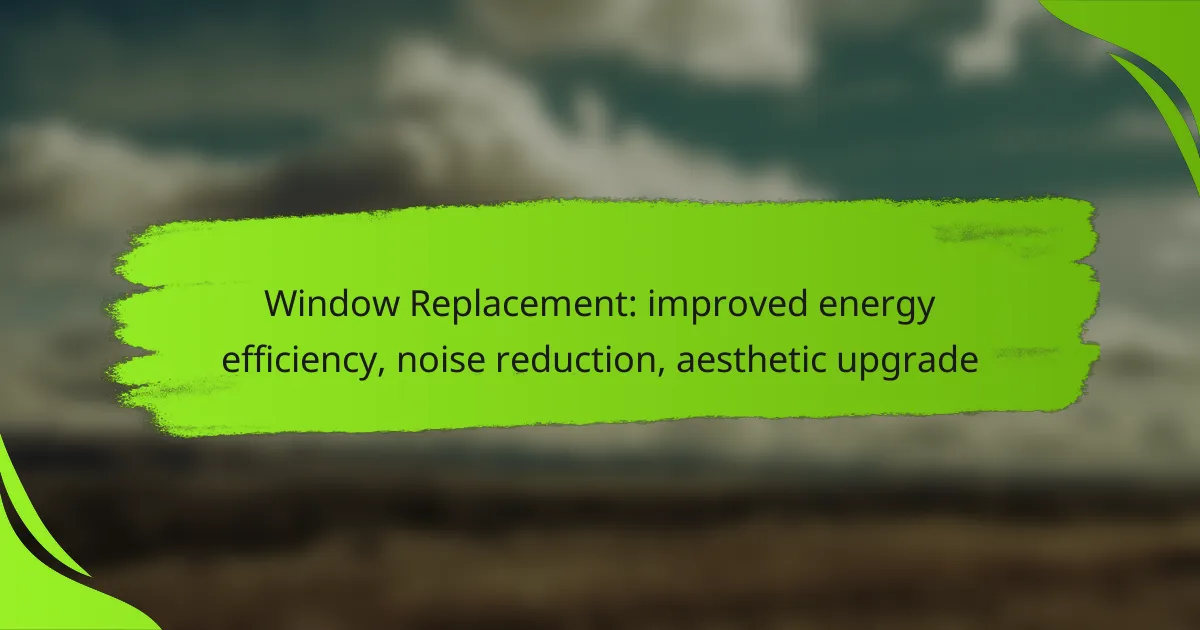Window replacement is a valuable investment that enhances energy efficiency, reduces noise pollution, and upgrades the aesthetic appeal of your home. By utilizing advanced technologies, new windows minimize heat loss and air leakage, leading to lower energy bills and increased comfort. Additionally, they can significantly block outside noise and introduce modern designs, transforming both the interior and exterior of your living space.

How does window replacement improve energy efficiency?
Window replacement enhances energy efficiency by reducing heat loss and minimizing air leakage. New windows often feature advanced technologies that help maintain indoor temperatures, leading to lower energy bills and improved comfort.
Double glazing benefits
Double glazing involves two panes of glass separated by a spacer, creating an insulating air gap. This design significantly reduces heat transfer, keeping homes warmer in winter and cooler in summer. Homeowners can expect energy savings of around 10-25% compared to single-pane windows.
Additionally, double glazing helps reduce external noise, making living spaces quieter. This is particularly beneficial in urban areas or near busy roads, where sound insulation can greatly enhance comfort.
Low-E glass technology
Low-E (low emissivity) glass is coated with a thin layer that reflects heat back into the room while allowing natural light to enter. This technology helps maintain consistent indoor temperatures and reduces reliance on heating and cooling systems. Homeowners can see energy savings of up to 20% when using Low-E glass.
Moreover, Low-E glass can block harmful UV rays, protecting furniture and flooring from fading. This added benefit contributes to the longevity of interior furnishings, making it a wise investment.
Insulated frames advantages
Insulated frames are designed to minimize thermal bridging, which occurs when heat escapes through the frame material. These frames often use materials like vinyl or fiberglass that provide better insulation compared to traditional wood or aluminum. This can lead to further energy savings and improved overall efficiency.
When selecting windows, consider the frame’s insulation value, often expressed as R-value. Higher R-values indicate better insulation, which is crucial for maximizing energy efficiency in any climate. Proper installation is also essential to ensure that these frames perform effectively.

What are the noise reduction benefits of window replacement?
Replacing windows can significantly reduce noise pollution in your home by utilizing advanced materials and technologies designed to block sound. This improvement not only enhances comfort but also contributes to a more peaceful living environment.
Soundproofing materials
Soundproofing materials play a crucial role in minimizing noise transmission through windows. Options like laminated glass, which incorporates a layer of sound-dampening material, can effectively reduce sound levels by up to 50%. Additionally, window frames made from vinyl or fiberglass can further enhance sound insulation compared to traditional wood or aluminum frames.
Impact of window seals
Properly sealed windows are essential for effective noise reduction. High-quality seals prevent air leaks and create a tighter barrier against external sounds. When replacing windows, look for models with multiple weatherstripping layers and compression seals, as these features can significantly improve sound insulation.
Acoustic glass performance
Acoustic glass is specifically designed to reduce sound transmission. This type of glass typically features varying thicknesses or multiple panes that disrupt sound waves. When considering window replacement, opting for acoustic glass can provide a noticeable decrease in noise, making it an excellent choice for homes in noisy urban areas or near busy roads.

How can window replacement enhance home aesthetics?
Window replacement can significantly improve the visual appeal of a home by introducing modern designs, varied colors, and unique shapes. These enhancements not only elevate the exterior look but also create a more inviting atmosphere inside.
Modern design options
Today’s window designs offer sleek lines and innovative styles that can transform a home’s appearance. Options like casement, double-hung, and sliding windows provide both functionality and aesthetic appeal. Selecting a design that complements your home’s architecture is crucial for achieving a cohesive look.
Consider energy-efficient designs that also enhance aesthetics, such as windows with low-profile frames or larger glass areas that maximize natural light. These features can make spaces feel more open and airy.
Color and finish choices
Choosing the right color and finish for your windows can dramatically affect your home’s curb appeal. Popular options include classic whites, deep blacks, and earthy tones that blend with natural surroundings. Custom finishes, like wood grain or matte textures, can add a unique touch to your windows.
When selecting colors, consider the overall color scheme of your home. A contrasting color can create a striking look, while a similar hue can provide a more subtle, unified appearance.
Custom window shapes
Custom window shapes allow homeowners to express their individuality and enhance architectural features. Options such as arches, circles, or even geometric designs can serve as focal points in a room or on the exterior of a house.
When opting for custom shapes, ensure they align with your home’s style and structure. Unique shapes can also improve natural light and ventilation, contributing to a more pleasant indoor environment.

What factors should be considered before window replacement?
Before replacing windows, consider energy efficiency, local building codes, and budget constraints. Each of these factors plays a crucial role in ensuring that the new windows meet your needs and comply with regulations.
Energy efficiency ratings
Energy efficiency ratings indicate how well windows insulate against heat loss and gain. Look for windows with a low U-factor, which measures thermal performance, and a high Solar Heat Gain Coefficient (SHGC) for better sunlight management. Energy Star certification is a reliable indicator of efficiency.
In many regions, energy-efficient windows can reduce heating and cooling costs by a significant percentage, often in the range of 10-25%. Consider double or triple-pane glass options for enhanced insulation.
Local building codes
Local building codes dictate the standards for window installation, including safety, energy efficiency, and structural integrity. Check with your local building authority to understand specific requirements that may affect your project.
Some areas may have regulations regarding the types of materials used or the installation methods. Ensure compliance to avoid potential fines or the need for costly rework.
Budget considerations
Budgeting for window replacement involves more than just the cost of the windows themselves. Factor in installation costs, which can vary widely based on the complexity of the job and local labor rates. A typical range for window replacement can be from a few hundred to several thousand dollars per window.
It’s wise to set aside additional funds for unexpected expenses, such as repairs to framing or insulation. Prioritize energy-efficient options, as they may offer long-term savings that justify a higher upfront investment.

What are the costs associated with window replacement?
Window replacement costs can vary significantly based on factors such as the type of windows, installation complexity, and regional labor rates. Homeowners should budget for both the installation and materials to understand the total investment required for improved energy efficiency and aesthetics.
Average installation costs
The average installation costs for window replacement typically range from a few hundred to several thousand dollars per window, depending on the complexity of the job and the type of windows selected. Labor costs can vary widely, often falling between $50 and $100 per hour, with total installation times ranging from a few hours to a full day.
Homeowners should consider obtaining multiple quotes from local contractors to ensure competitive pricing and to understand the scope of work involved. Look for contractors with good reviews and experience in window installation to avoid common pitfalls.
Cost of materials
The cost of materials for window replacement can range from low to high, depending on the window type. Basic vinyl windows may start around $200 each, while high-end wood or fiberglass options can exceed $1,000 per window. Energy-efficient models with double or triple glazing may also come at a premium but can provide significant savings on energy bills.
When selecting materials, consider factors such as durability, maintenance requirements, and energy ratings. Investing in quality materials can enhance both the aesthetic appeal and energy efficiency of your home.
Long-term savings analysis
While the upfront costs of window replacement can be substantial, the long-term savings often justify the investment. Energy-efficient windows can reduce heating and cooling costs by a notable percentage, leading to savings that accumulate over time. Homeowners may see a return on investment of 70% to 80% when selling their home, depending on local market conditions.
To maximize savings, consider windows with high energy ratings and low-E coatings. Additionally, take advantage of any available tax credits or rebates for energy-efficient home improvements, which can further offset costs.

What are the best window brands for energy efficiency?
The best window brands for energy efficiency typically include companies known for their high-performance products, such as Anderson, Pella, and Marvin. These brands often offer windows with advanced insulation, low-emissivity (Low-E) glass, and energy-efficient frames that can significantly reduce heating and cooling costs.
Key features to look for
When selecting energy-efficient windows, focus on features like double or triple glazing, Low-E coatings, and gas fills such as argon or krypton between panes. These elements enhance insulation, minimizing heat transfer and improving overall energy performance.
Additionally, consider the window frame materials. Vinyl and fiberglass frames generally provide better insulation compared to aluminum, which can conduct heat. Look for windows with a high Energy Star rating, as this indicates compliance with energy efficiency standards.
Cost considerations
Energy-efficient windows can range from moderate to high price points, typically starting around $300 and going up to $1,000 or more per window, depending on size and features. While the initial investment may be higher, the long-term savings on energy bills can make them cost-effective.
Keep in mind that local incentives or rebates may be available for energy-efficient upgrades, which can help offset costs. Research your area for any programs that promote energy efficiency in home improvements.
Installation and maintenance tips
Proper installation is crucial for maximizing the energy efficiency of your windows. Hire a qualified professional to ensure that windows are sealed correctly and fit snugly in their frames. Poor installation can lead to air leaks, negating the benefits of energy-efficient windows.
Regular maintenance, such as checking seals and cleaning the glass, will help maintain their performance. Inspect windows annually for any signs of wear or damage, and address issues promptly to avoid costly repairs later.
